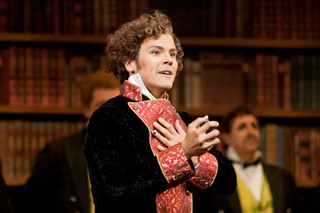|
Back
Light on dramma...heavy on giocoso San Diego
Civic Theater
10/22/2016 - & 25, 28, 30 October 2016
Gioachino Rossini: La Cenerentola
Lauren McNeese (Angelina/Cinderella), David Portillo (Prince Ramiro), José Adán Pérez (Dandini), Stefano de Peppo (Don Magnifico), Susannah Biller (Clorinda), Alissa Anderson (Tisbe), Ashraf Sewailam (Alidoro)
San Diego Opera and Chorus, Bruce Stasyna (Chorus Master), Jeff Thayer (Concertmaster), Gary Thor Wedow (Conductor)
Lindy Hume (Stage Director), Dan Potra (Scenic and Costume Designer), Matthew Marshall (Lighting Designer), Steven W. Bryant (Wig and Makeup Designer)

(© J. Katarzyna Woronowicz)
San Diego Opera continues to re-invent itself with a lighter-fare early season opener, Rossini’s La Cenerentola. With exception of two principals, the cast and artistic team members all make their house debut. To the general public there’s a whimsical freshness inside this Lindy Hume-driven staging that’s bound to appeal to new and existing patrons of the art plus a familial moral settlement based on a roughened outline of Charles Perrault’s 1697 conte de fées, Cendrillon. This production has introspections on both ends of the spectrum.
Since the music is the driving force behind any Rossini equation, newcomer Gary Thor Wedow mobilizes an exceptionally pleasing and well-maneuvered tempo. The orchestra (along with Catherine Miller’s piano recitative), allows singers to keep up with the momentum and complexities of the score. Ahead of the overture, Dan Potra’s wildly inventive sets ranging in color, texture, and perspective are first revealed with a two-dimensional library when a book suddenly (and appropriately) drops out of the bookcase on cue...one of many waggish extensions to come.
The action places La Cenerentola inside Edwardian England (1910s) with a hodge-podge of costuming which is, at times, perplexing. Instead of the traditional fairy-tale “castle”, we’re pulled inside Don Magnifico’s eye-candied “Emporium”, replete with concise detail and multi-props used to accentuate the action.

(© J. Katarzyna Woronowicz)
Rossini infused this comic opera with a combination of opera semiseria and opera seria. Ms. Hume holds true: we’re introduced to Lauren McNeese who nicely portrays her “downgrade” character with a small voice. At this point, however, the voce is wan and lost inside the orchestra. She’s referred to as being “cheeky” by her stepsister, Clorinda, but that’s the farthest thing from the truth: rather, she’s more confused, unsettled and saddened. In fact, there is much hilarity amongst the audience when Cinderella trips on the stairs which is actually a very pathetic moment, yet the reaction moves into the Comedy Club arena. Perhaps it was a cheap laugh at her expense. Ms. McNeese has a wonderful lower timbre, best displayed when she’s singing solo with piano orchestra. She broadens her character in steady fashion, but her coloratura flights get a bit raspy and chirpy. It seems Lauren McNeese takes more time to settle down in her character, for she appeared much at ease, more fluid in her coloratura and crowning vocal exercises at the end of the opera.
Antics are first presented through the stepsisters of Raggedy-Ann look-a-like Clorinda (Susannah Biller) and her sister, Tisbe (Alissa Anderson.) Their pouty excesses profuse and persist to the point of tedium. Sung by Stefano de Peppo, Don Magnifico appears to be in a time warp, harkening back to Harpo Marx by looking more bourgeoisie than royal. His actions in Act I towards Cinderella are almost threatening and abusive.
New to San Diego’s stage is José Adán Pérez as Dandini. The mimicries, though rather funny, are a bit overstated. For this baritone, the tessitura becomes rather muddied in Rossini’s low notes despite a chance for redemption. Dandini loves to be loved, and in this performance, he is.

(© J. Katarzyna Woronowicz)
Perhaps the two finest voices in the evening go to David Portillo as Prince Ramiro and his tutor, Ashraf Sewailam in the role of Alidoro. The moment Mr. Portillo appeared on stage, there was a careful diction, clarity and fabulous squillo to this tenor voice. Contrasting other principals, his carry was consistently unblemished with a moderate edge of deep passion for Cinderella which never over heated.
Sewailam’s Alidoro added yet another counterbalance to the relentless slapstick with his pure and powerful bass-baritone ring. There was passion and sincerity behind this voice, and his singing served him well during his aria, “Là del ciel nell’arcano profondo.”
Replacing Charles Prestinari in the choral wing is Bruce Stasyna who achieved firm delivery from his all-male contingent despite a chuckle or two at the “drag” factor which inconspicuously seeped into the production. One can’t help think we’re back in Mary Poppins and in the folds of George Banks.
Special commendation should go to Bernadette Torres as the Movement Coach. This production moves and doesn’t let down. The blocking and continual dress changes are insurmountable in La Cenerentola, so great credit goes to the behind-the-scenes support, including continued praises for Steven W. Bryant in the wig and makeup department.
Assuredly, this La Cenerentola will please most audiences with its heavy dose of shenanigans. Fun to watch, but more giacoso than dramma.
Christie Grimstad
|